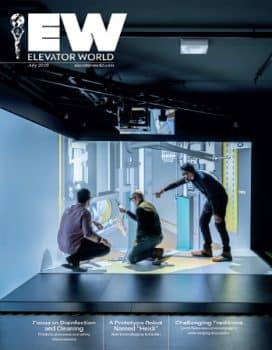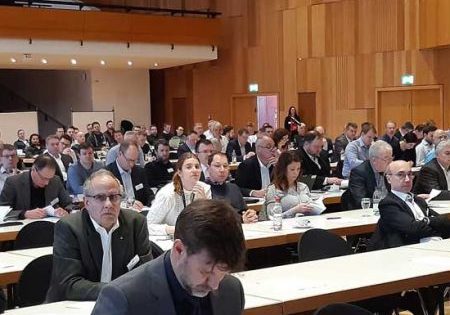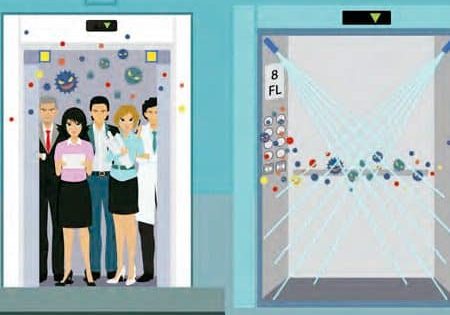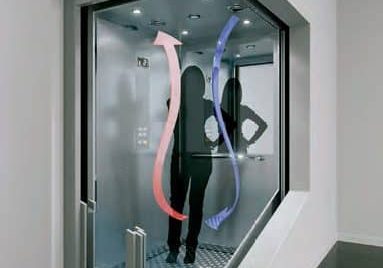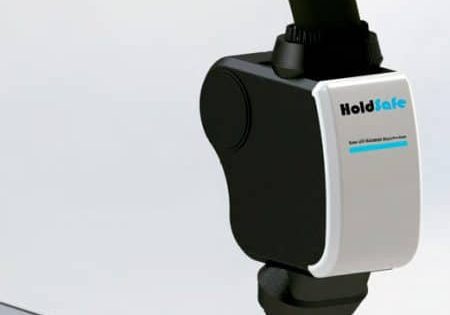Precautions and guidelines for passenger safety and field work
by Mustafa Kavukçu
The COVID-19 outbreak has changed many habits in our lives, which continue to change. Although the return to normal life has begun gradually, the outbreak is not over yet. Scientists state that the second or even third wave of the pandemic may arrive in the coming months. It seems that we might have to live longer under the threat of this outbreak. The duty of individuals and businesses is to take all precautions to protect against this virus at the maximum level. In this sense, the recommendations given here for the use of elevators contain what we need to do to protect against the virus.
Elevators can cause great risk due to their intensive use in places where human traffic is high, such as plazas, shopping malls, popular buildings, airports and hospitals. The biggest cause is that one of the most important scientist-recommended precautions, 1.5 m physical distance between people, cannot be practically applied in elevators. The reasons for this are mainly twofold, based on elevator car areas and capacities:
- Nominal weight of a passenger is considered 75 kg.
- While one person is standing upright, the distance between the person’s mouth and the dorsal side is roughly 23-30 cm, and the distance between the shoulders is 45-55 cm.
The cabin areas with which the industry must comply are shown in Table 8 of the TS EN 81-20 standard (shown here), which specifies “Human Numbers and Usable Minimum Areas.” The table clearly shows that the minimum available space of a four-person elevator cabin is 0.79 m2, while the cabin for 20 people is 3.13 m2. From these specifications, it does not seem possible to provide the recommended 1.5-m physical distance between people in an elevator.
Within the framework of this reality, there is only one option to protect passengers: lower passenger admission into the car to below the unit’s capacity. Two other important protective measures and behavior changes in using elevators are that passengers get on the elevators with a protective mask and try to avoid pressing the elevator buttons.
Getting few people into an elevator can slow down building traffic, which can cause traffic flow problems and complaints. However, the most important thing to remember is the health of the individual and society. Another measure is the presence of an attendant, who has taken constant and protective measures in the elevator so that passengers do not press the buttons in the car. This is one of the most critical measures to be taken to prevent the spread of the virus.
It should be a necessity for passengers to have a protective mask on when entering the car. Where elevator traffic is not
busy, disinfectant can be placed in front of the entrances, instead of with the attendant. Each person entering the car after using this disinfectant must always ride the elevator with a protective mask.
These applications can be expanded or reduced for all elevators, depending on the buildings’ density. Building managers and operators should be responsible for such practices. The semi-instructive recommendations that follow have the goal of helping users live a healthy life by keeping them from a danger that is invisible but has bad consequences. As all members of society are valuable, we do not want to lose them for not complying with these very simple regulations.
Elevator Riding Rules
Each elevator should have an attendant who presses the push button for passengers; passengers should not press any call buttons inside the car. Attendants should wear N95/FFP2 masks. Attendants should wear gloves. Next to the attendant, there should be 1:100 diluted bleach (sodium hypochlorite CAS No. 7681-52-9 solution) or a disinfectant that has been dissolved with a chlorine tablet. It should be ensured the attendant is exempt from COVID-19 or any other infectious disease and should carry the related document with them. (Building management could provide the attendant’s health report.) The attendant should ensure that the passenger who is entering the elevator wears a mask and accept only as many passengers in accordance with the elevator capacities specified below. The passengers should also be sent as far away from each other as possible, i.e., to the diagonal corners of the elevator.
If passengers have to stay close to each other or to an attendant in a car, they should stand back-to-back. The attendant should allow boarding up to the number of passengers specified in accordance with the following elevator capacities:
- One person, excluding the attendant, in capacities of
- 320- 450 kg
- Two People, excluding the attendant, in capacities of
- 450- 800 kg
- Three people, excluding the attendant, in capacities of
- 800- 1000 kg
- Four people in capacities of 1000-1500 kg
- For car capacities exceeding 1500 kg, passengers can be taken to the car in accordance with the elevator capacity.
The distance between the passengers should be as far as possible, and the passengers should stand with their backs to each other.
In hospitals, airports and similar places, if passengers can reach their floors by either escalator or elevator, attendants should canalize passengers to the escalator.
Building Management for Elevators
If the elevator has a fan for ventilation, the fan should blow the air from inside the car to the elevator shaft. The fans should be cleaned with 1:100 diluted bleach (sodium hypochlorite CAS No. 7681-52-9 solution), a disinfectant that has been dissolved with a chlorine tablet or with similar disinfectants at the end of each day.
If there is an air-conditioner in the elevator, its filters should be changed frequently, or it should not be operated if the ambient temperature is suitable. The call buttons on the floors of the elevator should be cleaned several times during the day with disinfectant solution. The elevator pit, hoistway, and elevator hoistway and ventilation covers should be disinfected every month.
Management should consider protective masks and gloves as domestic waste and take measures to put used masks and gloves in trashcans on the floors for this purpose.
Elevator Contractor/Maintenance Companies and Staff
If the technical configuration of the elevator allows, door opening and closing speeds should be brought to maximum to mitigate traffic problems. Increasing the speed of elevators operating below their rated speed can also contribute to this end. If this is possible, the elevator speed settings should be implemented, with the permission of the administration.
Each repair and maintenance employee working in the elevator must wear a mask and gloves as part of their personal protective equipment. Repair and maintenance personnel should wear NP95/FFP2 masks in outbreak centers such as hospitals and similar districts where there is high risk of contagion. Disinfectant should be available for hand-cleaning in machine rooms.
Elevator Use in Small Businesses and Residences
It is recommended to have disinfectant in the elevator for prior use by the person who presses the call buttons. In cases where this is not possible, all car and landing operating panels should be cleaned by building management several times during the day with the aforementioned disinfectant solution(s). Passengers entering the elevator must wear masks and follow the other recommended rules as in the previous section “Elevator Riding Rules.”
| Number of passengers | Minimum available car area (m2) | Number of passengers | Minimum available car area (m2) |
| 1 | 0,28 | 11 | 1,87 |
| 2 | 0,49 | 12 | 2,01 |
| 3 | 0,60 | 13 | 2,15 |
| 4 | 0,79 | 14 | 2,29 |
| 5 | 0,98 | 15 | 2,43 |
| 6 | 1,17 | 16 | 2,57 |
| 7 | 1,31 | 17 | 2,71 |
| 8 | 1,45 | 18 | 2,85 |
| 9 | 1,59 | 19 | 2,99 |
| 10 | 1,73 | 20 | 3,13 |
Get more of Elevator World. Sign up for our free e-newsletter.

